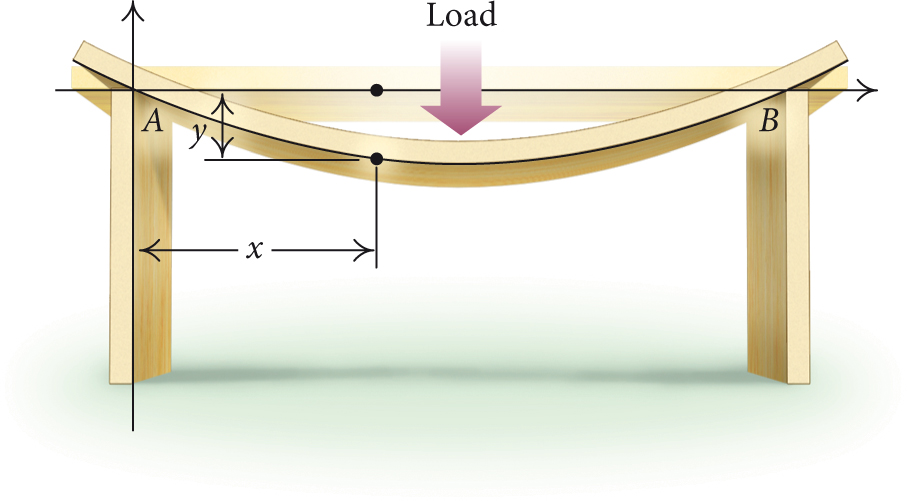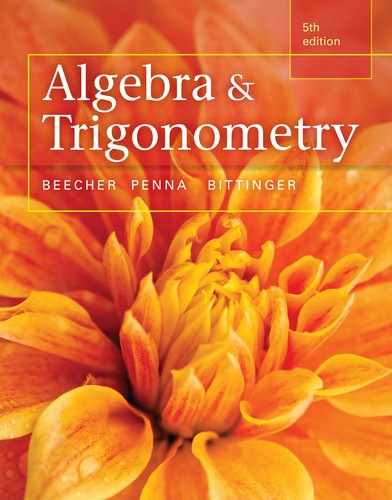4.3 Polynomial Division; The Remainder Theorem and the Factor Theorem
Perform long division with polynomials and determine whether one polynomial is a factor of another.
Use synthetic division to divide a polynomial by x−c
x−c .Use the remainder theorem to find a function value f(c)
f(c) .Use the factor theorem to determine whether x−c
x−c is a factor of f(x)f(x) .
In general, finding exact zeros of many polynomial functions is neither easy nor straightforward. In this section and the one that follows, we develop concepts that help us find exact zeros of certain polynomial functions with degree 3 or greater.
Consider the polynomial
The factors are
and the zeros are
When a polynomial is expressed in factored form, each factor determines a zero of the function. Thus if we know the factors of a polynomial, we can easily find the zeros. The “reverse” is also true: If we know the zeros of a polynomial function, we can find the factors of the polynomial.

Division and Factors
When we divide one polynomial by another, we obtain a quotient and a remainder. If the remainder is 0, then the divisor is a factor of the dividend.
Example 1
Divide to determine whether x+1
Solution
We divide x3+2x2−5x−6

Since the remainder is 0, we know that x+1
We divide x3+2x2−5x−6
Since the remainder, 24, is not 0, we know that x−3
Now Try Exercise 3.
When we divide a polynomial P(x)
As in arithmetic, to check a division, we multiply the quotient by the divisor and add the remainder, to see if we get the dividend. Thus these polynomials are related as follows:

For instance, if P(x)=x3+2x2−5x−6
The Remainder Theorem and Synthetic Division
Consider the function
When we divided h(x)
Note that the function values are the same as the remainders. This suggests the following theorem.
Proof (Optional). The equation f(x)=d(x)⋅Q(x)+R(x)
The remainder R(x)
Thus the function value f(c)
The remainder theorem motivates us to find a rapid way of dividing by x−c
4x2+5x+11x−24x3−3x2+x+74x3−8x2¯5x2+x5x2−10x¯11x+711x−22¯29
4x2+5x+11x−24x3−3x2+x+74x3−8x2¯¯¯¯¯¯¯¯¯¯¯¯¯¯5x2+x5x2−10x¯¯¯¯¯¯¯¯¯¯¯¯¯¯11x+711x−22¯¯¯¯¯¯¯¯¯¯¯¯¯29 45111−24−3+1+74−8¯5+15−10¯11+711−22¯29
45111−24−3+1+74−8¯¯¯¯¯¯¯¯5+15−10¯¯¯¯¯¯¯¯¯11+711−22¯¯¯¯¯¯¯¯¯¯¯29 The division in (B) is the same as that in (A), but we wrote only the coefficients. The red numerals are duplicated, so we look for an arrangement in which they are not duplicated. In place of the divisor in the form x−c
x−c , we can simply use c and then add rather than subtract. When the procedure is “collapsed,” we have the algorithm known as synthetic division.Synthetic Division

We “bring down” the 4. Then we multiply it by the 2 to get 8 and add to get 5. We then multiply 5 by 2 to get 10, add, and so on. The last number, 29, is the remainder. The others, 4, 5, and 11, are the coefficients of the quotient, 4x2+5x+11
When using synthetic division, we write a 0 for a missing term in the dividend.
Example 2
Use synthetic division to find the quotient and the remainder:
Solution
First, we note that x+3=x−(−3)
The quotient is 2x2+x−3
Now Try Exercise 13.
We can now use synthetic division to find polynomial function values.
Example 3
Given that f(x)=2x5−3x4+x3−2x2+x−8
Solution
By the remainder theorem, f(10)
Thus, f(10)=170,802
Now Try Exercise 25.
Compare the computations in Example 3 with those in a direct substitution:
Example 4
Determine whether 5 is a zero of g(x)
Solution
We use synthetic division and the remainder theorem to find g(5)
Since g(5)=0
Now Try Exercise 31.
Example 5
Determine whether i is a zero of f(x)
Solution
We use synthetic division and the remainder theorem to find f(i)

Since f(i)=0
Now Try Exercise 35.
Finding Factors of Polynomials
We now consider a useful result that follows from the remainder theorem.
Proof (Optional). If we divide f(x)
Then if f(c)=0
so x−c
The factor theorem is very useful in factoring polynomials and hence in solving polynomial equations and finding zeros of polynomial functions. If we know a zero of a polynomial function, we know a factor.
Example 6
Let f(x)=x3−3x2−6x+8
Solution
We look for linear factors of the form x−c
Since f(−1)≠0
Since f(1)=0
The trinomial x2−2x−8
Our goal is to solve the equation f(x)=0
The solutions of the equation x3−3x2−6x+8=0
Now Try Exercise 41.
4.3 Exercise Set
1. For the function
f(x)=x4−6x3+x2+24x−20,f(x)=x4−6x3+x2+24x−20, use long division to determine whether each of the following is a factor of f(x)
f(x) .x+1
x+1 x−2
x−2 x+5
x+5
2. For the function
h(x)=x3−x2−17x−15,h(x)=x3−x2−17x−15, use long division to determine whether each of the following is a factor of h(x)
h(x) .x+5
x+5 x+1
x+1 x+3
x+3
3. For the function
g(x)=x3−2x2−11x+12,g(x)=x3−2x2−11x+12, use long division to determine whether each of the following is a factor of g(x)
g(x) .x−4
x−4 x−3
x−3 x−1
x−1
4. For the function
f(x)=x4+8x3+5x2−38x+24,f(x)=x4+8x3+5x2−38x+24, use long division to determine whether each of the following is a factor of f(x)
f(x) .x+6
x+6 x+1
x+1 x−4
x−4
In each of the following, a polynomial P(x)
5. P(x)=x3−8,d(x)=x+2
P(x)d(x)==x3−8,x+2 6. P(x)=2x3−3x2+x−1,d(x)=x−3
P(x)d(x)==2x3−3x2+x−1,x−3 7. P(x)=x3+6x2−25x+18,d(x)=x+9
P(x)d(x)==x3+6x2−25x+18,x+9 8. P(x)=x3−9x2+15x+25,d(x)=x−5
P(x)d(x)==x3−9x2+15x+25,x−5 9. P(x)=x4−2x2+3,d(x)=x+2
P(x)d(x)==x4−2x2+3,x+2 10. P(x)=x4+6x3,d(x)=x−1
P(x)d(x)==x4+6x3,x−1
Use synthetic division to find the quotient and the remainder.
11. (2x4+7x3+x−12)÷(x+3)
(2x4+7x3+x−12)÷(x+3) 12. (x3−7x2+13x+3)÷(x−2)
(x3−7x2+13x+3)÷(x−2) 13. (x3−2x2−8)÷(x+2)
(x3−2x2−8)÷(x+2) 14. (x3−3x+10)÷(x−2)
15. (3x3−x2+4x−10)÷(x+1)
16. (4x4−2x+5)÷(x+3)
17. (x5+x3−x)÷(x−3)
18. (x7−x6+x5−x4+2)÷(x+1)
19. (x4−1)÷(x−1)
20. (x5+32)÷(x+2)
21. (2x4+3x2−1)÷(x−12)
22. (3x4−2x2+2)÷(x−14)
Use synthetic division to find the function values. Then check your work using a graphing calculator.
23. f(x)=x3−6x2+11x−6; find f(1), f(−2), and f(3).
24. f(x)=x3+7x2−12x−3; find f(−3), f(−2), and f(1).
25. f(x)=x4−3x3+2x+8; find f(−1), f(4), and f(−5).
26. f(x)=2x4+x2−10x+1; find f(−10), f(2), and f(3).
27. f(x)=2x5−3x4+2x3−x+8; find f(20) and f(−3).
28. f(x)=x5−10x4+20x3−5x−100; find f(−10) and f(5).
29. f(x)=x4−16; find f(2), f(−2), f(3), and f(1−√2).
30. f(x)=x5+32; find f(2), f(−2), f(3), and f(2+3i).
Using synthetic division, determine whether the numbers are zeros of the polynomial function.
31. −3, 2; f(x)=3x3+5x2−6x+18
32. −4, 2; f(x)=3x3+11x2−2x+8
33. −3, 1; h(x)=x4+4x3+2x2−4x−3
34. 2, −1; g(x)=x4−6x3+x2+24x−20
35. i, −2i; g(x)=x3−4x2+4x−16
36. 13, 2; h(x)=x3−x2−19x+19
37. −3, 12; f(x)=x3−72x2+x−32
38. i, −i, −2; f(x)=x3+2x2+x+2
Factor the polynomial function f(x). Then solve the equation f(x)=0.
39. f(x)=x3+4x2+x−6
40. f(x)=x3+5x2−2x−24
41. f(x)=x3−6x2+3x+10
42. f(x)=x3+2x2−13x+10
43. f(x)=x3−x2−14x+24
44. f(x)=x3−3x2−10x+24
45. f(x)=x4−7x3+9x2+27x−54
46. f(x)=x4−4x3−7x2+34x−24
47. f(x)=x4−x3−19x2+49x−30
48. f(x)=x4+11x3+41x2+61x+30
Sketch the graph of the polynomial function. Follow the procedure outlined on p. 240. Use synthetic division and the remainder theorem to find the zeros.
49. f(x)=x4−x3−7x2+x+6
50. f(x)=x4+x3−3x2−5x−2
51. f(x)=x3−7x+6
52. f(x)=x3−12x+16
53. f(x)=−x3+3x2+6x−8
54. f(x)=−x4+2x3+3x2−4x−4
Skill Maintenance
Solve. Find exact solutions. [3.2]
55. 2x2+12=5x
56. 7x2+4x=3
Consider the function
in Exercises 57–59.
57. What are the inputs if the output is −14? [3.2]
58. What is the output if the input is 3? [1.2]
59. Given an output of −20, find the corresponding inputs. [3.2]
60. Movie Ticket Price. The average price of a movie ticket has increased linearly over the years, rising from $2.69 in 1980 to $8.38 in 2013 (Source: Motion Picture Association of America). Using these two data points, find a linear function, f(x)=mx+b, that models the data. Let x represent the number of years after 1980. Then use this function to estimate the average price of a movie ticket in 1995 and in 2018. [1.4]
61. The sum of the base and the height of a triangle is 30 in. Find the dimensions for which the area is a maximum. [3.2]
Synthesis
In Exercises 62 and 63, a graph of a polynomial function is given. On the basis of the graph:
Find as many factors of the polynomial as you can.
Construct a polynomial function with the zeros shown in the graph.
Can you find any other polynomial functions with the given zeros?
Can you find any other polynomial functions with the given zeros and the same graph?
62.

63.

64. For what values of k will the remainder be the same when x2+kx+4 is divided by x−1 and by x+1?
65. Find k such that x+2 is a factor of x3−kx2+3x+7k.
66. Beam Deflection. A beam rests at two points A and B and has a concentrated load applied to its center, as shown below. Let y= the deflection, in feet, of the beam at a distance of x feet from A. Under certain conditions, this deflection is given by
y=113x3−114x.Find the zeros of the polynomial in the interval [0, 2].

Solve.
67. 2x2x2−1+4x+3=12x−4x3+3x2−x−3
68. 6x2x2+11+60x3−7x2+11x−77=1x−7
69. Find a 15th-degree polynomial for which x−1 is a factor. Answers may vary.
Use synthetic division to divide.
70. (x4−y4)÷(x−y)
71. (x3+3ix2−4ix−2)÷(x+i)
72. (x2−4x−2)÷[x−(3+2i)]
73. (x2−3x+7)÷(x−i)
